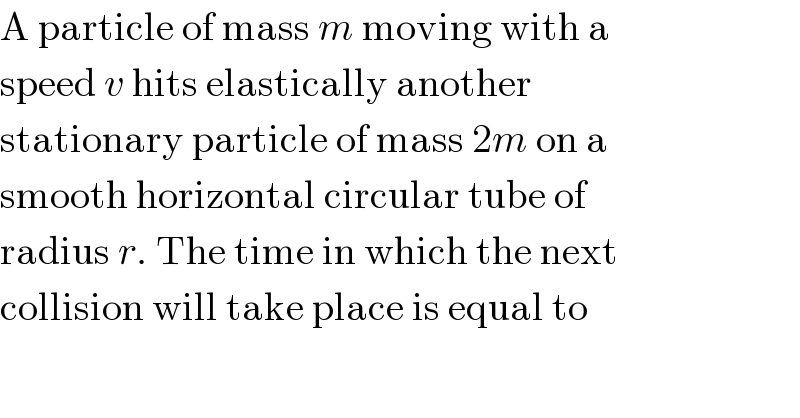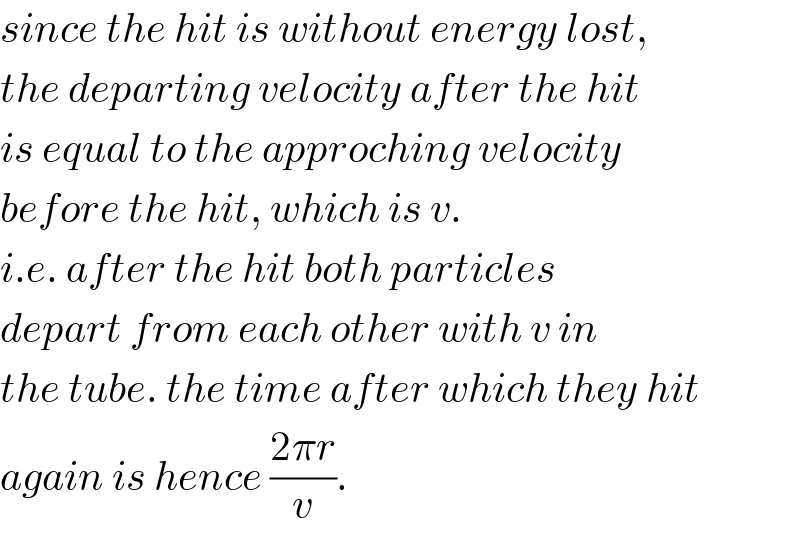
Question Number 24945 by Tinkutara last updated on 29/Nov/17

$$\mathrm{A}\:\mathrm{particle}\:\mathrm{of}\:\mathrm{mass}\:{m}\:\mathrm{moving}\:\mathrm{with}\:\mathrm{a} \\ $$$$\mathrm{speed}\:{v}\:\mathrm{hits}\:\mathrm{elastically}\:\mathrm{another} \\ $$$$\mathrm{stationary}\:\mathrm{particle}\:\mathrm{of}\:\mathrm{mass}\:\mathrm{2}{m}\:\mathrm{on}\:\mathrm{a} \\ $$$$\mathrm{smooth}\:\mathrm{horizontal}\:\mathrm{circular}\:\mathrm{tube}\:\mathrm{of} \\ $$$$\mathrm{radius}\:{r}.\:\mathrm{The}\:\mathrm{time}\:\mathrm{in}\:\mathrm{which}\:\mathrm{the}\:\mathrm{next} \\ $$$$\mathrm{collision}\:\mathrm{will}\:\mathrm{take}\:\mathrm{place}\:\mathrm{is}\:\mathrm{equal}\:\mathrm{to} \\ $$
Commented by Tinkutara last updated on 30/Nov/17

$$\mathrm{Thank}\:\mathrm{you}\:\mathrm{Sir}! \\ $$
Commented by mrW1 last updated on 29/Nov/17

$${since}\:{the}\:{hit}\:{is}\:{without}\:{energy}\:{lost}, \\ $$$${the}\:{departing}\:{velocity}\:{after}\:{the}\:{hit} \\ $$$${is}\:{equal}\:{to}\:{the}\:{approching}\:{velocity} \\ $$$${before}\:{the}\:{hit},\:{which}\:{is}\:{v}. \\ $$$${i}.{e}.\:{after}\:{the}\:{hit}\:{both}\:{particles} \\ $$$${depart}\:{from}\:{each}\:{other}\:{with}\:{v}\:{in} \\ $$$${the}\:{tube}.\:{the}\:{time}\:{after}\:{which}\:{they}\:{hit} \\ $$$${again}\:{is}\:{hence}\:\frac{\mathrm{2}\pi{r}}{{v}}. \\ $$
Commented by mrW1 last updated on 29/Nov/17

$${I}\:{think}\:{it}\:{doesn}'{t}\:{matter}\:{which}\:{mass} \\ $$$${they}\:{have}. \\ $$
Commented by mrW1 last updated on 30/Nov/17
![this is the proof: let m_2 =λm_1 before the hit: particle 1: v particle 2: 0 after hit: particle 1: u_1 particle 2: u_2 m_1 v=m_1 u_1 +m_2 u_2 ⇒v=u_1 +λu_2 ...(i) (1/2)m_1 v^2 =(1/2)m_1 u_1 ^2 +(1/2)m_2 u_2 ^2 ⇒v^2 =u_1 ^2 +λu_2 ^2 ...(ii) (i) into (ii) ⇒v^2 =v^2 −2λvu_2 +λ^2 u_2 ^2 +λu_2 ^2 ⇒λu_2 [(λ+1)u_2 −2v]=0 ⇒(λ+1)u_2 =2v ⇒u_2 =(2/(λ+1))×v ⇒u_1 =v−λ×((2v)/(λ+1))=((1−λ)/(λ+1))×v ⇒Δu=u_2 −u_1 =((2−1+λ)/(λ+1))×v=v i.e. after hit the particles depart from each other with the same velocity as they approch to each other before the hit. the time till next collision is hence ((2πr)/v)](Q24968.png)
$${this}\:{is}\:{the}\:{proof}: \\ $$$${let}\:{m}_{\mathrm{2}} =\lambda{m}_{\mathrm{1}} \\ $$$${before}\:{the}\:{hit}: \\ $$$${particle}\:\mathrm{1}:\:{v} \\ $$$${particle}\:\mathrm{2}:\:\mathrm{0} \\ $$$${after}\:{hit}: \\ $$$${particle}\:\mathrm{1}:\:{u}_{\mathrm{1}} \\ $$$${particle}\:\mathrm{2}:\:{u}_{\mathrm{2}} \\ $$$${m}_{\mathrm{1}} {v}={m}_{\mathrm{1}} {u}_{\mathrm{1}} +{m}_{\mathrm{2}} {u}_{\mathrm{2}} \\ $$$$\Rightarrow{v}={u}_{\mathrm{1}} +\lambda{u}_{\mathrm{2}} \:\:\:...\left({i}\right) \\ $$$$\frac{\mathrm{1}}{\mathrm{2}}{m}_{\mathrm{1}} {v}^{\mathrm{2}} =\frac{\mathrm{1}}{\mathrm{2}}{m}_{\mathrm{1}} {u}_{\mathrm{1}} ^{\mathrm{2}} +\frac{\mathrm{1}}{\mathrm{2}}{m}_{\mathrm{2}} {u}_{\mathrm{2}} ^{\mathrm{2}} \\ $$$$\Rightarrow{v}^{\mathrm{2}} ={u}_{\mathrm{1}} ^{\mathrm{2}} +\lambda{u}_{\mathrm{2}} ^{\mathrm{2}} \:\:\:\:...\left({ii}\right) \\ $$$$\left({i}\right)\:{into}\:\left({ii}\right) \\ $$$$\Rightarrow{v}^{\mathrm{2}} ={v}^{\mathrm{2}} −\mathrm{2}\lambda{vu}_{\mathrm{2}} +\lambda^{\mathrm{2}} {u}_{\mathrm{2}} ^{\mathrm{2}} +\lambda{u}_{\mathrm{2}} ^{\mathrm{2}} \\ $$$$\Rightarrow\lambda{u}_{\mathrm{2}} \left[\left(\lambda+\mathrm{1}\right){u}_{\mathrm{2}} −\mathrm{2}{v}\right]=\mathrm{0} \\ $$$$\Rightarrow\left(\lambda+\mathrm{1}\right){u}_{\mathrm{2}} =\mathrm{2}{v} \\ $$$$\Rightarrow{u}_{\mathrm{2}} =\frac{\mathrm{2}}{\lambda+\mathrm{1}}×{v} \\ $$$$\Rightarrow{u}_{\mathrm{1}} ={v}−\lambda×\frac{\mathrm{2}{v}}{\lambda+\mathrm{1}}=\frac{\mathrm{1}−\lambda}{\lambda+\mathrm{1}}×{v} \\ $$$$\Rightarrow\Delta{u}={u}_{\mathrm{2}} −{u}_{\mathrm{1}} =\frac{\mathrm{2}−\mathrm{1}+\lambda}{\lambda+\mathrm{1}}×{v}={v} \\ $$$${i}.{e}.\:{after}\:{hit}\:{the}\:{particles}\:{depart}\:{from} \\ $$$${each}\:{other}\:{with}\:{the}\:{same}\:{velocity} \\ $$$${as}\:{they}\:{approch}\:{to}\:{each}\:{other}\:{before} \\ $$$${the}\:{hit}. \\ $$$${the}\:{time}\:{till}\:{next}\:{collision}\:{is}\:{hence} \\ $$$$\frac{\mathrm{2}\pi{r}}{{v}} \\ $$
